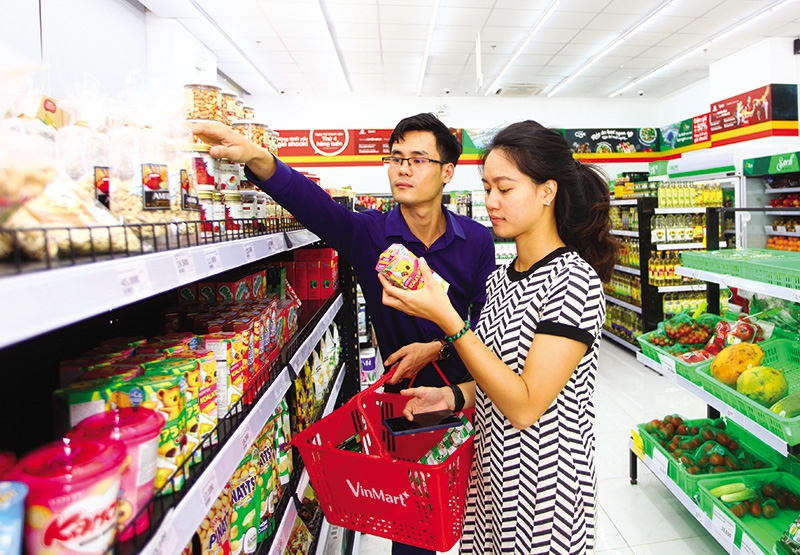Requiring data to stay on retail track
 |
| Demand cannot be fully met if manufacturers cannot adapt to changing needs in time, Photo: Le Toan |
Companies in fast-moving consumer goods (FMCG) have to manage complex supply chains, particularly on the distribution side. Production tends to be pretty efficient as products are usually rather simple to make, but the distribution has its load of challenges.
 |
| Julien Brun, managing partner of CEL Consulting |
The complexities come from the fact that a company has to reach tens of thousands of small outlets all over the country from only one or two manufacturing plants. This creates a very complex network with multiple parties involved including distributors, e-commerce companies, retail chains, and logistics companies, and so on.
The main transformation that Vietnam is currently seeing in this industry is the evolution of channels. Modern trade (retail chains, supermarkets, or convenience stores) is developing fast and takes volume from general trade (small family stores), while the emergence of e-commerce is going to further accelerate and take another piece of the volume from traditional retail.
It is important to understand that this shift makes it even more difficult for brands to figure out where to sell what and how. Without data, you are completely blind, thus increasing the risk of getting it wrong.
Data will drive retail and distribution chains in the near future. However, the very first step, which is in itself extremely complex, is that companies start to integrate their supply chain by connecting their ordering systems. A retail chain would send an automatic order to a manufacturer when stock is needed. That could allow much more efficient logistics and inventory management that would benefit everyone.
The challenge is technical as this integration is still very heavy. The evolution of lighter, more agile IT solutions for the supply chain will allow easier integration in the future which is going to drive a massive amount of cost, greenhouse emissions, stock, and space out from the supply chain. But it will take quite some time, investment, and collaborative spirit from manufacturers, distributors, and retailers.
Manufacturers are going to have to be more connected to their customers. Today, surprisingly, not many FMCG brands know where its products are being sold and how. They mostly push their products to distributors and then hope that they will reach the consumers in one way or another. So it is common to see issues in product availability, that is, shortages of stock, leading to lost sales. At the same time, too much stock is available at the wrong place. Thus, distribution is rather inefficient for manufacturers as they lack visibility on what is happening between them and the consumers.
The evolution to expect is that manufacturers with enough technological mastery will start to link consumer and retail insights coming from sales data to the supply chain. Demand intelligence will allow to better understand consumer behaviour patterns and adapt their distribution network as well as their product assortment.
This will be a massive step to the maturity of distribution in Vietnam. However, it will take a few years as this technique is still under exploration in more mature market like the EU, the US, China, and South Korea.
In parallel, the evolution of last mile delivery companies in Vietnam will allow even smaller manufacturers to play in the market. Links between factories and consumers become shorter as these last mile players make it much easier to support online sales.
Most recently, the VinMart 4.0 virtual store run by VinCommerce under Vingroup has been launched in Vietnam. Customers need to only open the VinID app, select the Scan & Go feature, scan the QR code of the products they wish to buy at VinMart 4.0, and pay with the VinID app. VinMart will deliver goods within two to four hours.
At this stage, VinMart’s Scan & Go system is at its infancy and it does not work due to implementation issues such as payment limitation and the process still being cumbersome for users. It currently does not add much value to anyone. However, it will slowly evolve to a smoother system and allow users to spend less time shopping. The data from this system will provide consumer insights helping to recommend products and highlight promotions mostly with the use of rather traditional machine learning algorithms. Nothing is very new here.
The efficiency will come when this consumer behaviour data is shared along the supply chain so manufacturers themselves can understand how to adapt to consumer’s needs and purchasing habits.
Currently, this data is owned and kept secret by VinMart for sales purposes, and are not made available for supply chain development yet. Unfortunately, in Vietnam the retailer data is kept secret which prevents the entire chain to be in sync and become more efficient.
VinMart is certainly trying to launch proven techniques by linking online and offline purchasing experience. Before this picks up at a significant level, it will take four or five years and a lot of money invested in the IT infrastructure.
Overall, the main challenge in FMCG supply chains is to get data from consumers. That is why brands spend a lot of money on market research, surveys, competitions, and events that allow to collect consumer data to understand their behaviour.
However, this is often small data (limited amount of observation where statistics do not necessarily work well) as opposed to retailer or e-commerce companies that have massive amount of data about how and where consumers consume.
Until FMCG manufacturers have access to retailer data, they will have a hard time to really meet demand. They may realise that a product is not selling well anymore, but much too late to have adapted their product portfolio accordingly. They may miss massive amounts of sales opportunities as they have no information about where their products are in the distribution network. If the retail shelves are empty, then no sales can happen and a consumer would pick another product. The problem is rather simple, but you can only address it when you see it.
As consumers become more fussy and demand new products, keen to move from one channel to another for home delivery, it will be even more important for manufacturers to be fully aware of these expectations and evolution in consumer behaviour.
We are still very far from it in the real world, but the outlook is exciting.
What the stars mean:
★ Poor ★ ★ Promising ★★★ Good ★★★★ Very good ★★★★★ Exceptional
Related Contents
Latest News
More News
- Global partnerships key to Vietnam’s IFC development (December 26, 2025 | 16:18)
- Vingroup pulls out of bid to invest in North-South high-speed railway (December 26, 2025 | 11:42)
- Strengthening supply chains through trade promotions and customs reform (December 24, 2025 | 14:00)
- PM orders investment model for North–South high-speed rail (December 22, 2025 | 17:43)
- LS Eco Energy to invest in Vietnam rare earth sector (December 22, 2025 | 17:31)
- Government moves to establish International Financial Centre (December 21, 2025 | 21:00)
- Vietnam's IFC to target global investment flows (December 21, 2025 | 18:00)
- Two national hospitals expand capacity with new facilities (December 20, 2025 | 09:00)
- Ha Tinh breaks ground on major Vingroup industrial and energy projects (December 19, 2025 | 18:24)
- EVN launches major power infrastructure projects nationwide (December 19, 2025 | 18:17)

 Tag:
Tag:





















 Mobile Version
Mobile Version